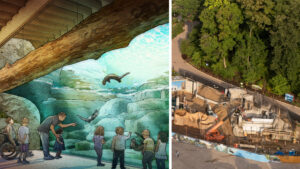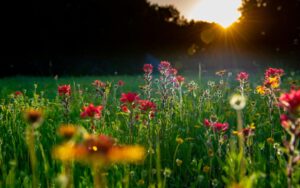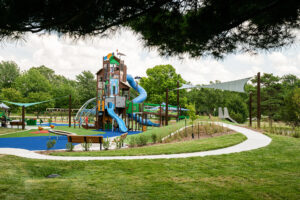With the first incandescent light bulb’s invention in 1897, the human experience was forever changed, and with it so too was the night sky. Today, the effects of artificial lighting are expansive, and there is a renewed shift towards a return to darkness and its hidden benefits. In this conversation, we spoke with Ruskin Hartley, CEO of DarkSky International, a conservationist at heart who leads a global movement for natural night skies, combating light pollution’s harm to health, wildlife, ecosystems, and climate.
The DarkSky International website is an impressive wealth of resources, including a searchable list of Dark Sky Certified places, a database of DarkSky Approved products, companies, and lodging, and public outreach and education materials free to use without modification. Check it out!
Key Takeaways
Natural Darkness Is a Critical Habitat That We’re Losing at an Astonishing Rate.
Rainforests. Coral reefs. Native grasslands. Conservation projects associated with these habitats are ubiquitous in zoo and aquarium strategies. But natural darkness is also its own, often forgotten, critical habitat for an innumerable number of species that we are losing at an astonishing rate. The reality, Ruskin observed, is that the conservation community still needs to catch up to the profound nature of this change.
With few exceptions, conservation strategies fail to account for a species’ relationship to natural darkness and the positive impact a reduction in light pollution could have on that species’ survival and recovery. For example, 90% of amphibian species are active at night, and more than 40% of amphibian species are at risk of extinction. A brief internet search points to emerging research that suggests light pollution may contribute to this global decline, interfering with reproduction and other biological processes. Zoos and aquariums worldwide are already engaged in critically important amphibian conservation; addressing light pollution in key habitats is an additional opportunity to reinforce and build healthy populations.
“Like clean air and clean water, a dark night sky should be put in the pantheon of things worth protecting.” – Ruskin Hartley
Even Dim Light Can Impact Animals. And Plants!
Evidence is growing that even dim light can profoundly affect plants and animals. Most of our family and friends could tell us how lights on and near beaches can severely disorient nesting and hatchling sea turtles or that migrating birds are at a high risk of collision with brightly lit skyscrapers. But many would be amazed by the number of species that rely on the lunar cycle – consider the dim glow of a moon’s crescent compared to the brighter light of a full moon; that slight difference can trigger an animal’s biological response.
Ruskin shared just a few marine examples among many: clownfish will not reproduce with even the dimmest levels of light, the rise and fall of phytoplankton in the water column is in response to lunar cycles, and many coral species are known to synchronize their reproductive behavior by the moon. Even city trees exposed to street lights hold onto their leaves longer than they should in autumn, which is a problem when frost hits.
Knowing that the problem is not just in brightly lit beachfront condos and city skyscrapers reinforces all efforts to reduce light pollution, no matter how seemingly small.
Reducing Light Pollution Doesn’t Mean a Return to Candlelight.
This conversation occurred in December amid houses, streets, and many, many zoos and aquariums decked with string lights. “The answer to light pollution is not to turn off all the lights all the time and plunge us into medieval darkness.”, assured Ruskin. Light at night brings tremendous benefits to society, and sustainable solutions to light pollution focus on the quality of light and intentionality around light spectrums and schedules.
Ruskin shared DarkSky International’s “Five Lighting Principles for Responsible Outdoor Lighting”:
- – Useful: Use light only if it is needed.
- – Targeted: Direct light so it falls only where it is needed.
- – Low Level: Light should be no brighter than necessary. Brighter light isn’t always better.
- – Controlled: Use light only when needed; employ timers & motion detectors.
- – Warm-colored: Use warmer color lights where possible.
Zoos and aquariums have a significant opportunity to evaluate their campus lighting for ways to apply these five lighting principles and reduce light pollution from parking lots, entrances, pathways, and even those evening events that have become a critical revenue source for many outdoor organizations, extending hours, capacity and access. If outdoor sports can shift dramatically towards the responsible lighting of playing fields at night (see DarkSky’s Outdoor Sports Lighting Program Certification), so can zoos and aquariums.
We Have the Tools We Need to Make a Difference Tonight.
When we flood the nighttime environment with light, it impacts essentially every living thing. But as we’ve already discussed, there are simple things that can be done tonight to reduce light pollution and move towards healthier, safer communities and environments. This conversation left some GLMV Zoos ECHO team members with an epiphany. Many threats to communities and environments are wildly complex. Solutions to climate change, overexploitation, disease, invasive species, etc, are complicated and divisive. But of all these enormous issues, light pollution is one we can easily do something about. Every individual and every organization have the agency to make a change tonight that will make a meaningful difference to human and wildlife health.
And at a systematic level, imagine a world where zoos and aquariums collaborated with DarkSky International to establish lighting standards, even a certification program, for zoo and aquarium campuses. The collective, radiating impact would be astounding.




